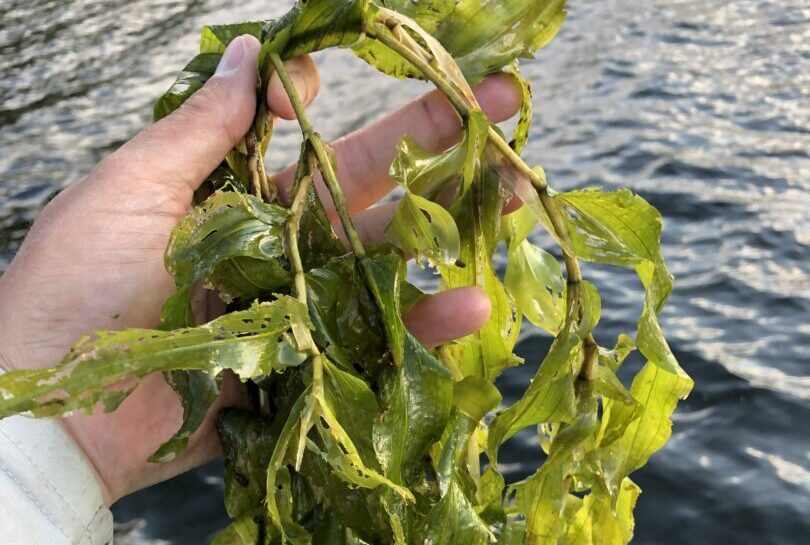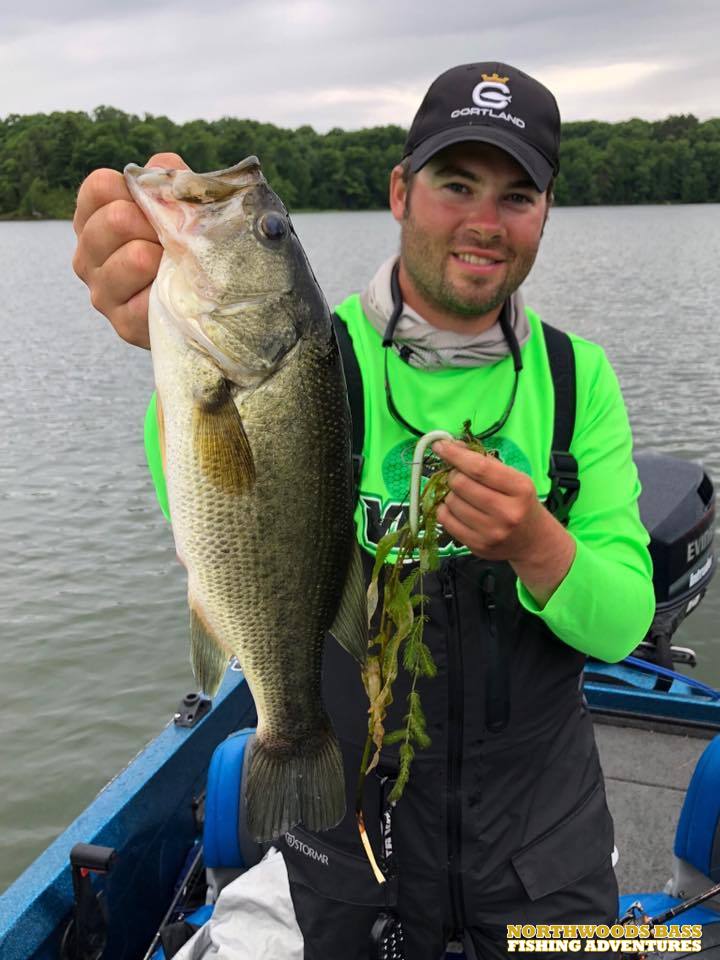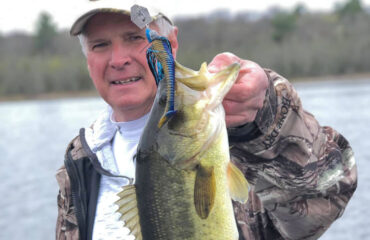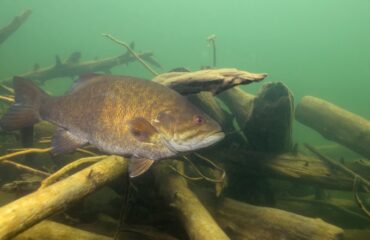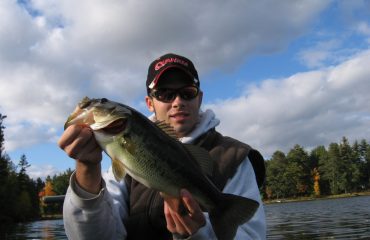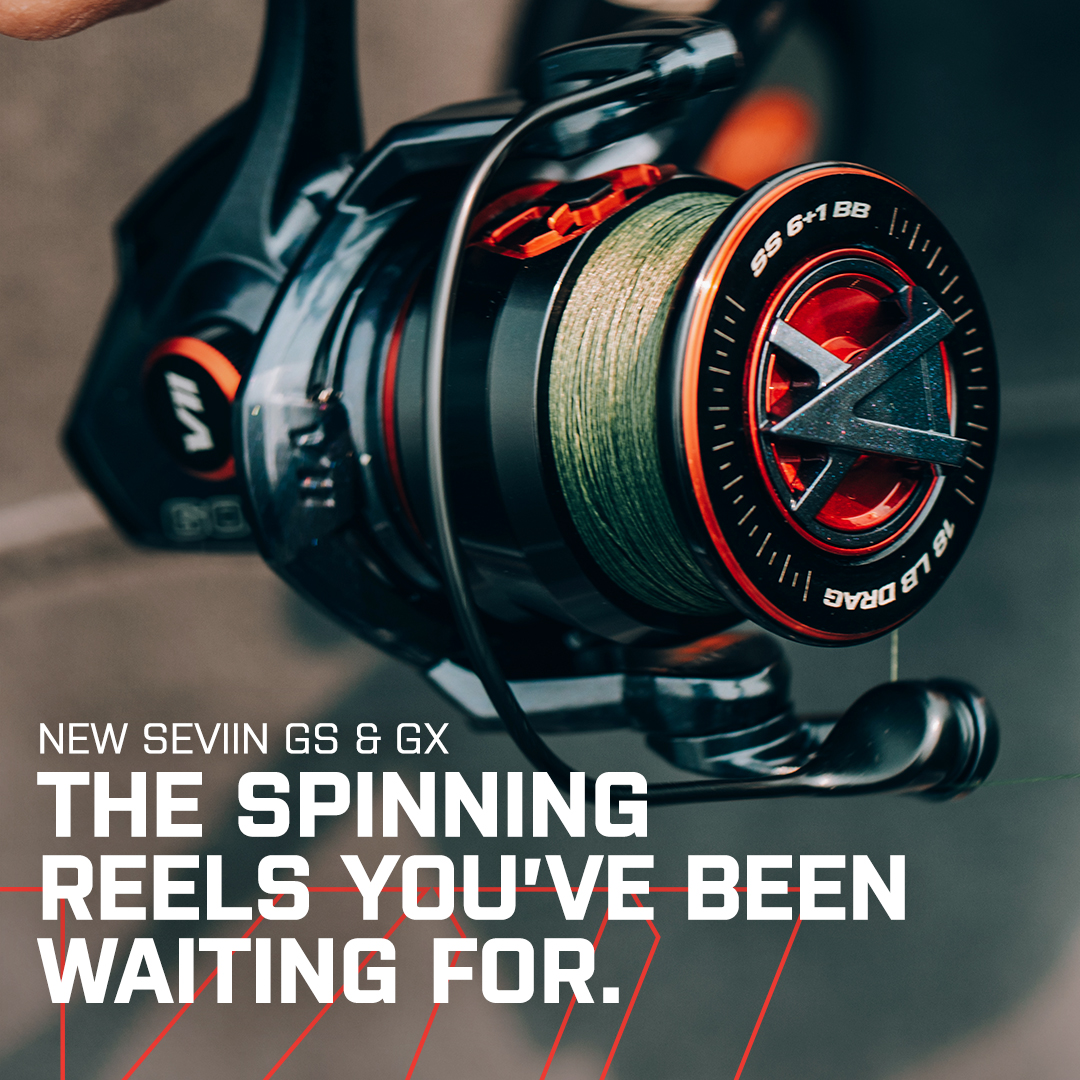Favorite Plant Species
Across most North American waters, aquatic plant species form the foundation of healthy and flourishing underwater ecosystems. Underwater vegetation will not only protect water quality and lead to healthier habitats, but they also produce life-giving oxygen and play host to several fish species.
As the cradle of life in many waters, it makes sense that the best fishing spots available in a lake are usually associated with weed beds. They supply important reproductive, protective, feeding, and nursery habitats for fish and invertebrates. In order to maintain healthy fisheries, we must also maintain these healthy and native plant communities that are so vital to a lake’s fertility and its fishing productivity.
To catch more fish from weeds, anglers must learn how every specific weed species they encounter caters to fish and why certain fish species gravitate to them for their own feeding and survival.
Plant Perspectives
Whether native or invasive, aquatic vegetation offers more advantages than disadvantages to gamefish. The stalks, vines, and leaves of plants offer vantage points for stalking prey and openings for a successful ambush. Watch out if you’re a young of the year perch, bluegill or minnow species, because the lives and feeding patterns of most freshwater gamefish species revolves around plant life year-round.
The presence of aquatic vegetation allows them to lurk in solitary or in small packs, in wait of vulnerable prey.
Packs of largemouths often work together for feeding. Schools of walleyes come and go too, spring through summer and later on at first ice. Meanwhile more territorial and solitary muskies and pike follow suit as well, whose presence along the deep outer edges gets dictated by seasonal habits, water temperature, and their personal needs. Panfish species find comfort and feeding opportunities in these habitats too.
Submergent plants grow from the lake bottom up through the water column towards the surface, where sunlight feeds them with energy to photosynthesize and oxygenate. Depending on the water clarity and light penetration, certain weed species such as coontail, milfoil and green cabbage variants are capable of growing to depths of 15 to 20 feet or more.
If you’ve ever wondered why plant species often segregate from other species, it’s because of competition. Submerged plants compete amongst themselves and other species, fighting for space to root, grow and reproduce. Large weed beds will commonly feature several different plant species that have learned to co-exist together. Meanwhile isolated weed beds usually contain one single species that has rooted and established itself to the lake bottom.
Plant Perspectives
Favorite Plants
Every lake is created and composed differently. Due to the diversity of aquatic vegetation, it would be most beneficial if anglers were able to identify the most common species inhabiting their lakes and favorite fisheries before making a first cast.
Here in my lakes of Northern Wisconsin, most gamefish habitat on eutrophic and mesotrophic lakes are vegetated. Native plant species like bulrushes, lily pads, coontail, northern milfoil, and pondweed varietals are most common. Meanwhile non-native invasives and introduced species like Eurasian milfoil, hydrilla, bladderwort, and curly-leaf pondweed may also be featured and in some cases take over the entire lake.
Each of the following showcased plant species are targeted the most for my fishing. Here’s where I find them, what primary fish species uses them, and how I best fish them.
Coontail
Also known as hornwort, is known for its ability to disperse along the lake bottom to depths of 15 ft or more. Coontail is a rootless, submerged plant found growing in extremely dense colonies or as floating mats. It has multiple branching soft stems that can be 10 feet in length, and can grow in depths as shallow as 1 ft and as deep as 20 ft.
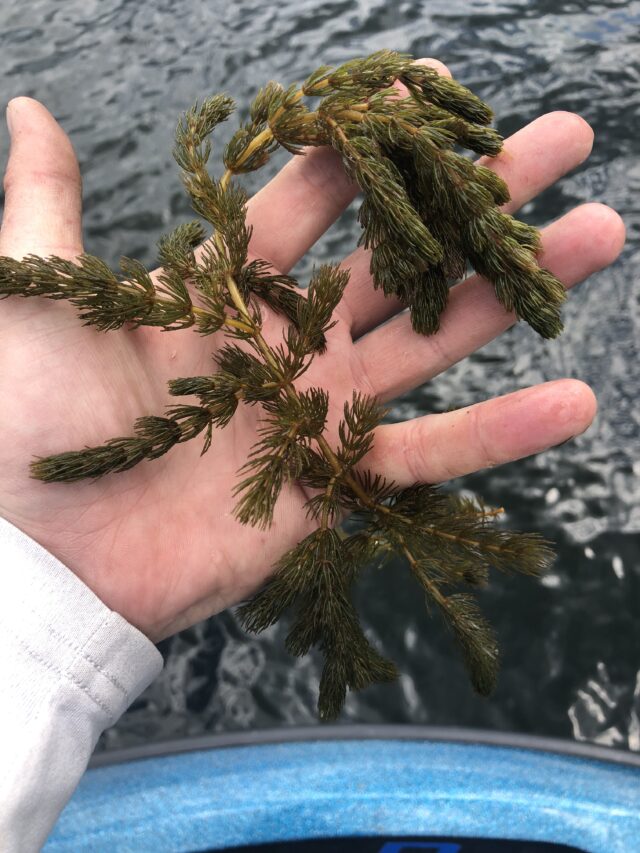
Coontail will thicken in the summer months where it becomes a heavily used feeding grounds for walleyes, smallmouths, and largemouths.
Across many inland lakes I fish, summer walleye and smallmouth locations are driven by the location of coontail. It provides cover to these gamefish, while also attracting baitfish that includes young of the year yellow perch and a variety of minnow species. In some lakes with reduced visibility, a lot of it grows shallower than you think. It grows deep in many others, where it will also be a factor in the fall months. Finding it is achievable with good side imaging such as Lowrance’s Active Imaging with its 3-in-1 transducer. In the shallows, you’ll know it’s there if you see the plant’s crowns barely protruding above the surface.
I tend to observe walleyes hiding and laying comfortably near its stalks and openings. Bass on the other hand prowl along the edges and use it for ambushing. Presence of nearby forage species makes it all more attractive.
Spring and summer walleye anglers frequently pitch jig and plastic combos, rip baits, and slip bobber rigs to thick walls, pockets, and patches. Walleyes will come and go all the time until prompted to relocate elsewhere.
Bass anglers meanwhile like to locate isolated beds in deeper water where they’ll concentrate on pods of fish holding to them. In late summer into fall, a number of smallmouths get taken by drop-shotting, Carolina rigging, Ned rigging, and crankbaiting strategies.
Largemouths most frequently occupy coontail beds in shallow water. The more stained and bloomed the visibility, the better it’ll be. I’ve caught some of my best fish to date from these areas with the swim jig and paddletail combo, Texas rigged creature baits, and weedless wacky worms. Just like walleyes are capable of, largemouths can occupy coontail beds in big numbers.
Pondweeds
BROADLEAF CABBAGE – There are several pondweed species and varietals found throughout North America. Broadleaf cabbage, also referred to as “tobacco weed” and “musky weed” is prime fish real-estate across the northern waters it inhabits. On my waters, it grows in patches on large expansive shallow weed flats and along drop-offs. I find that broadleaf cabbage is a shallower-associated plant species than its close relative, the green cabbage.
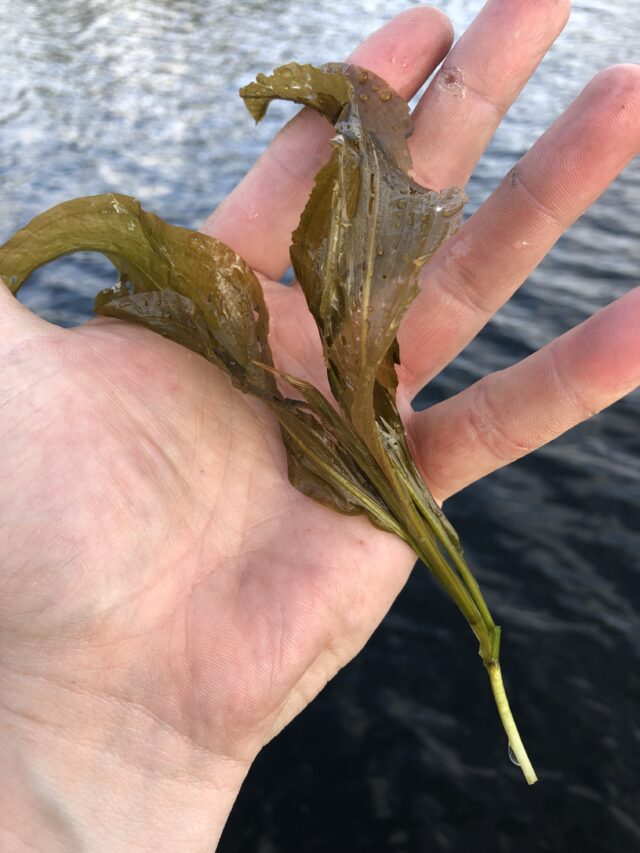
Broadleaf cabbage provides excellent early season and summer habitat for panfish species such as crappies, largemouth bass, muskies, and pike. Each fish species enjoys the lush oxygen, comfort, and protection provided by the plant.
Panfish often nest near these plants and eat insects and invertebrates found on the leaves. In late spring through early summer, walleyes use these pondweeds for cover in shallow bays and near-shore as soon as they begin sprouting. Often overlooked, smallmouths frequently visit these plants from summer into early fall if they grow in isolation nearby sand and hard bottom locations where they attract schools of perch. Last, some of the best muskie waters in the state contain several spots featuring this cabbage. An important early fall shallow-water muskie pattern for us is targeting these isolated cabbage beds with topwaters and bucktails.
Broadleaf cabbage is important fish habitat on every water it’s present in. Unfortunately, the removal of this species by shoreline property owners across several Northwoods lakes has prompted less desirable junk species and non-native invasives to get introduced and establish in its place.
GREEN CABBAGE – Likewise found in the northern states, green cabbage (white-stem pondweed) has a zig-zag stem that is thin and sparingly branched. Wavy green leaves are alternately arranged, translucent, two to 11 inches long, and one-half to nearly two inches wide. Green pondweed grows in clear, deep water, and requires a cold winter period to promote germination for the following year.
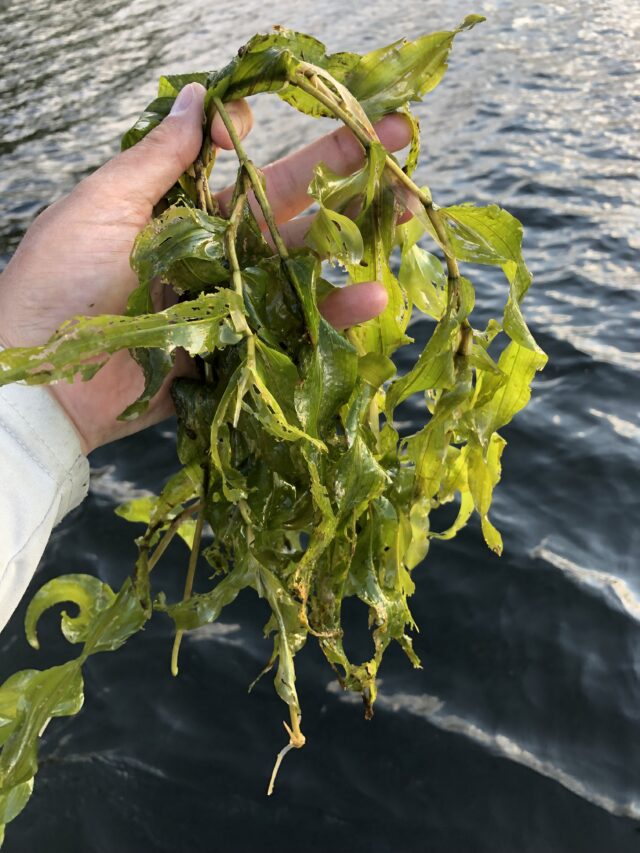
Many of my best largemouth bass and muskie fishing lakes contain several weed beds and deep weedlines of green cabbage. Once fully established, on the onset of summer peak, it becomes a player for all the deep weedline fishing we will do through year’s end.
Unlike broadleaf cabbage, green cabbage has a longer life span as the deepest-growing stalks producing much-needed oxygen can last through late fall into early ice. These characteristics are what makes late-season deep weedline fishing productive and this pattern so predictable every year.
The magic depth for this plant species tends to be between 10 and 15 feet. I find this species more appealing to gamefish because in these depths all fish species have the entire water column of the plant and its edges to utilize.
Prioritize fishing the edges and outside edges as often as possible. On my local waters, massive congregations of juvenile bluegills are drawn to these locations. Groups of largemouths commonly cruise the outside edges, scouting for prey and then flushing them out. If positioning the boat next to the edge, vertical presentations like a drop shot and jig works best. If positioned a cast-length away, parallel casting swim jigs, jig and wacky rigs, Carolina rigs, and crankbaits are my top choices. Locate the plants, establish the edge, find the fish, and you’ll be in business whether seeking largemouths, muskies, walleyes, or panfish.
Northern Watermilfoil
There are several species of water milfoil found throughout North America. This plant species has soft feather-like leaves with leaflets. Northern watermilfoil is often mistaken for coontail or Eurasian watermilfoil, but it does not branch at the surface as much as Eurasian watermilfoil does and neither do its heads turn red color. Northern typically has half as many leaflet pairs as Eurasian has. Its leaves are rigid when removed from the water, but Eurasian leaves are limp when out of water. The northern species also forms winter buds (groups of dark, brittle leaves) in late fall and winter while the Eurasian variety does not.

This plant species is common to many lakes. In some it grows sparse and is well-controlled by other competing plant species, while in others it can quickly overtake the entire lake bottom if given too much freedom to grow and expand further. Depths vary anywhere from 1 to 20 feet.
Fry and juvenile fish will utilize the dense internal cover for their recruitment and protection, while predators such as pike, muskies, and largemouth bass use the edges to ambush prey and the dense mats for shade.
For pike and largemouths, ripping reaction lures such as spinnerbaits, lipless crankbaits, and chatterbaits draws bone-jarring strikes. If located deep and under the mats, jig and creatures and punch rigs score big numbers of largemouths. For muskies, casting and covering water with topwaters and bucktails across the deeper depths during the summer months is the norm.
I feel that too much milfoil and vast never-ending beds of it makes finding fish more difficult. Most gamefish will not occupy the entire edge and weed line. And if fish are scattered all over, they’ll be more difficult to run into. Thus, it is important to pick apart irregularities, points, pockets, and openings with aid of side imaging. Quality fish are more apt to be in these areas rather than bury themselves deep in it.
Elodea (Elodea Canadensis)
Elodea canadensis is a native plant, found in lakes in depths up to 10 feet. Often, anglers think they are fishing hydrilla when they’re actually fishing a similar native plant known as elodea, or Canadian waterweed. This plant provides all of the good matting potential of hydrilla without growing into depths and places that impede fishing and navigation. It can be difficult telling hydrilla and elodea apart, but elodea is much smaller than all the other look-alike plant species.
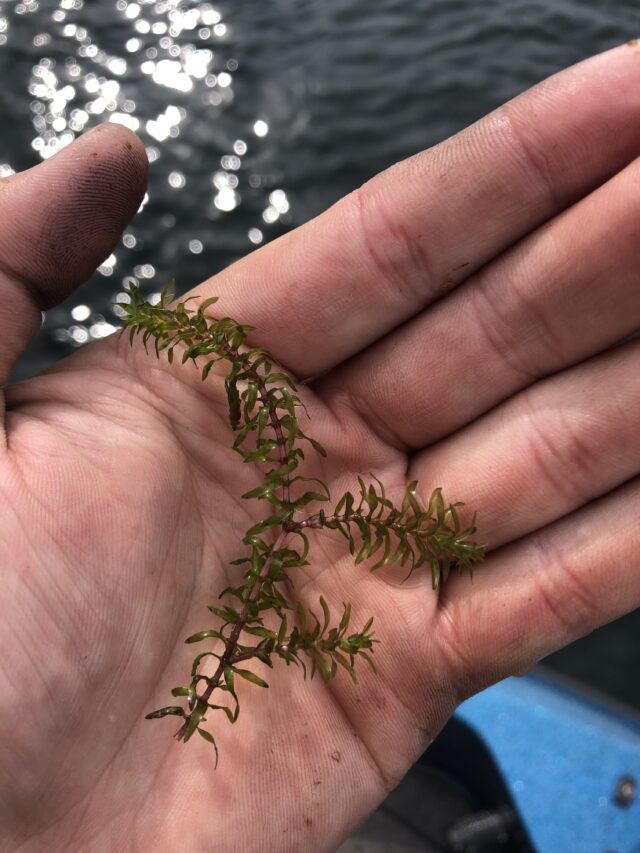
Elodea is a bottom-hugging species. It is a submersed aquatic plant with elongate, often branched stems and simple linear or lanceolate leaves. Bass and walleyes utilize the outer edges and the tops of elodea colonies as ambush sites, while juvenile and forage species will utilize the denser mats to escape predation.
I frequently cast and burn with lipless crankbaits, squarebills and bladed swim jigs through the tops. This plant species is present in more waters than you think, and most often in the clearer, less fertile and more featureless waters. Where fish have not much else to gravitate towards, this plant gets used.
Lilly Pads
These rooted flowering plants grow in mucky or silty bottoms up to 5 feet deep. Floating plants provide overhead cover, which largemouth bass and other sunfish species instinctively gravitate to. Water lilies are perennials, sprouting from their stalks and complex underwater root systems annually.
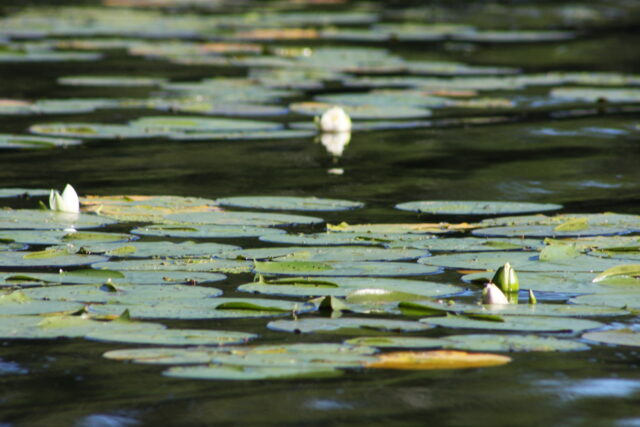
Pads also provide early season cover too. As largemouths migrate into shallow mud bottom bays right after ice-out, the network of roots and stalks provide cover. As lilies develop in spring, many bass will remain in the thickening beds through the summer months. The shade they provide helps bass approach prey without detection. The more irregularities pad fields have, the better. These open pockets will offer feeding oases and casting lanes.
Nothing in bass fishing is more exciting than the exhilarating strikes and timing of the hook-set with topwaters, buzzbaits, and surface frogs.
Not a Plant but Close – Sand Grass
On the bottom of lakes there is a complex organism serving as the lake’s cradle of life and provider of health and the fisheries’ well-being: sand grass. It is a fish magnet to baitfish, panfish, walleyes, bass, and muskies.
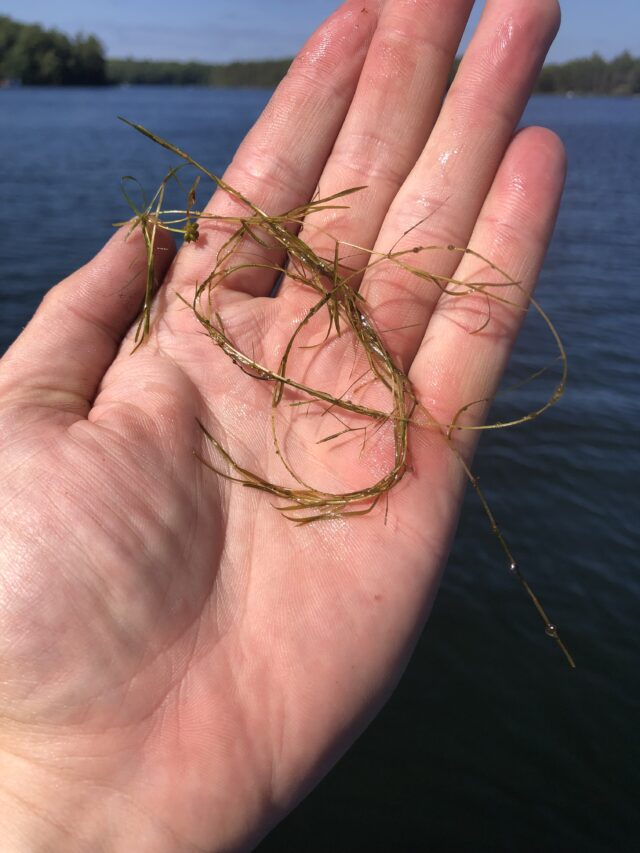
Sand grass, commonly referred to as “chara” or “nitella,” is the most advanced form of algae. Often mistaken for a plant, it’s a complex organism that continually photosynthesizes to the sun and grows into short thick mats year-round. These commonly blanket a lake’s basin in depths of 15 to 25 feet and are branched with no root system. Sand grass may grow upward into the water column, providing an even greater attraction and appeal for fish that includes suspending smallmouths and muskies. Sand grass is light green and yellow in color with stems and branches that are hollow with rough ends. When crushed, these emit a musty scent.
In all lakes where it’s established, sand grass is an integral component to the habitat and health of fisheries. Chara and nitella is a promoter of water clarity and bottom stabilization, prevents sediment buildup and slows the aging process of lakes. It drives the ecosystem and provides food and cover for macroinvertibrates, forage species and predators, produces rich oxygen content for the entire biomass and is the epicenter of an entire lake’s food web.
Many lakes with sand grass rear healthy populations of walleyes and smallmouths. Sand grass is unique in that it grows in deeper water more than any other aquatic plant and often is the only deep-water cover available in lakes. It attracts and holds fish year-round, including in winter.
On my fisheries, the sand grass pattern begins to take shape in midsummer. Muskies and walleyes are most frequently pursued. Smallmouths gravitate to it too, where they’ll prioritize it in late summer through fall and potential wintering too. To ice anglers, the sand grass pattern across deep lake basins is a trusted bite for walleyes and panfish.
Sand grass can be too expansive, so thicker clumps with unique features that grow upward into the water column and specific spots differentiating from most other areas of the bed are best. Open pockets in between clumps and grass beds are high-percentage locations too, providing all fish species with protection and ambush points for feeding.
Do Your Species ID
You could save thousands just by simply examining what your baits extract from the lake bottom if they’ve been fouled. Ideally, you’ll want to utilize modern-day electronics and side-imaging to locate and identify the plant species in your waters, and examine how fish are positioning along their edges.
Side imaging enables anglers to examine weed beds and their edges at long-distance from each side of the boat while on plane and at idling speeds. My Lowrance Active-Imaging 3-in-one transducer with HDS 12 Live units works marvelously. Down-imaging used in conjunction with fish-reveal will display the shape and features of every plant, and what could be inhabiting them. It still requires time and study, but the more you look at your screens the interpretation and differentiating between cabbage, milfoil, coontail, and other plant species becomes easier.
Learn to differentiate between plant species, and study everything underwater in your local waters. Snag some plants. Take some shots with an underwater camera. Run your electronics. Or go for a dive. The more you learn about aquatic plant species and see how fish use them and set themselves up, the better angler you’ll be.
Better knowledge of aquatic vegetation and how your favorite fish species associate to them will give you a huge advantage in knowing where to go, what to fish, and where to cast in order to make them bite.
Lowrance HDS Live Side Imaging
Andrew Ragas splits time between the Chicago area and Wisconsin’s Northwoods. Based in Minocqua, WI, he specializes in trophy bass fishing and offers guided trips from May thru October. While big bass is the passion, he dabbles in multi-species as well. He may be visited online at www.northwoodsbass.com


